Roby Sweet's Blog, page 74
July 31, 2015
Some Thoughts on Trophy Hunting: Miss C’s Modest Proposal
<!--[if gte mso 9]>
Published on July 31, 2015 02:30
July 29, 2015
Gottfried Mind Print of Fighting Cats
Wordless Wednesday
Two Domestic Cats
Fighting.
Lithograph, ca. 1820–1860.
Artist: Gottfried
Mind (1768–1814).
Lithographer: Joseph Brodtmann (1787–1862).
Via Library of Congress Prints and Photographs Division.
<!--[if gte mso 9]>
Normal
0
false
false
false
EN-US
X-NONE
X-NONE
Two Domestic Cats
Fighting.
Lithograph, ca. 1820–1860.
Artist: Gottfried
Mind (1768–1814).
Lithographer: Joseph Brodtmann (1787–1862).
Via Library of Congress Prints and Photographs Division.
<!--[if gte mso 9]>
Normal
0
false
false
false
EN-US
X-NONE
X-NONE
Published on July 29, 2015 02:30
July 27, 2015
July 24, 2015
July 22, 2015
A Man and His Cat, Nineteenth-Century Style
Wordless Wednesday
Portrait of a man and his cat.
It seems that even in the nineteenth century, people liked
to include their pets in their portraits, as seen in this daguerreotype of an unidentified man with a cat, c.
1840–1860. Of course we’re not sure this cat actually belonged to this man, but
it would be odd for the man to pose with someone
Portrait of a man and his cat.
It seems that even in the nineteenth century, people liked
to include their pets in their portraits, as seen in this daguerreotype of an unidentified man with a cat, c.
1840–1860. Of course we’re not sure this cat actually belonged to this man, but
it would be odd for the man to pose with someone
Published on July 22, 2015 02:30
July 17, 2015
Lost and Found and Lost Again: The Travels of President Calvin Coolidge’s Cat
Some cats are such dedicated wanderers that they just won’t stay home—even if “home” happens to be the White House. President Calvin Coolidge and his wife, Grace, found this out the hard way in 1924 when their cat named Tige (for “Tiger”) went wandering not once but twice. This is the story of Tige’s comings and goings, pieced together from what news reports we could find.
The Coolidge zooThe Coolidges occupied the White House beginning in August 1923 when Calvin became president after Warren G. Harding’s sudden death. By the time they left in 1929, the Coolidge White House had been home to quite an assortment of animals, including several dogs (we counted thirteen listed by the Presidential Pet Museum), two canaries, a thrush, a goose, a mockingbird, two cats (Tige and Blacky), two raccoons, a donkey, and a bobcat. Then there were two lion cubs, a wallaby, a pygmy hippo, and a black bear. I swear I am not making this up.
Tige’s first disappearance results in radio broadcast, new collar
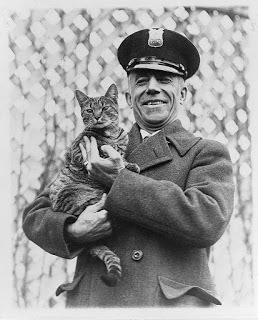
Mr. Benjamin Fink, the Navy Department
guard who found Tige and returned him
to the White House, poses proudly with the
wayward feline. March 25, 1924.
According to the original photo caption,
Fink found Tige “promenading” around the
Navy Building a few blocks from the White
House and immediately took him back home.
The photo is part of the National Photo
Company Collection, Library of Congress.The striped tomcat named Tige seems to have been something of an adventurer, and on Friday, March 21, 1924, he went missing from the White House. He could not be found over the weekend, and on the following Monday evening, “at the request of White House officials,” a radio appeal was made for his return. Stations WCAP in Washington and WEAF in New York made the “lookout” broadcast, reporting that the cat had been missing since the previous week. The notice went out to the eastern half of the country.
The appeal worked, as on the following day, a guard found Tige wandering in the vicinity of the Navy Building (which was along Constitution Avenue, a few blocks from the White House) and delivered the cat back home. (Reported in the Boston Daily GlobeMar. 25, 1924.)
On March 27, the Boston Daily Globe reported that “a nice broad collar was bought for Tige today on which his name and address is inscribed.” The collar also had a bell on it (Washington Post, July 24, 1924). The president apparently believed this collar would make it easier to have Tige returned if he got away again, and it probably would have, if a tourist hadn’t later taken it as a souvenir. (Clearly, White House security has changed a lot since then.)
Tige’s second disappearance, this time for goodJust three months later, sometime in late June 1924, Tige again went missing. Both the Washington Post and Boston Daily Globe reported on July 24 that the cat had been lost for a month and was presumed to be gone for good. Coolidge had reportedly decided against a second radio announcement because “Tige plainly had indicated his preference for society other than that found around the White House.”
As far as we know, Tige was never returned to the Coolidges, making this a sad lost-cat tale, though we hope that the wandering tiger cat found a comfortable place to settle down.
Published on July 17, 2015 02:30
July 15, 2015
A Fierce Moche Feline, in Ceramic
Wordless Wednesday
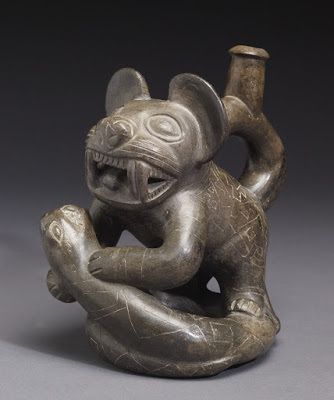
Feline Effigy Stirrup Vessel. Moche culture, Peru.AD 50-800 (Early Intermediate-Middle Horizon).Ceramic grayware.H: 6 3/4 x W: 6 1/4 in. Creative CommonsAttribution-Share Alike 3.0 Unported LicenseVia the Walters Art Museum, Baltimore.

Feline Effigy Stirrup Vessel. Moche culture, Peru.AD 50-800 (Early Intermediate-Middle Horizon).Ceramic grayware.H: 6 3/4 x W: 6 1/4 in. Creative CommonsAttribution-Share Alike 3.0 Unported LicenseVia the Walters Art Museum, Baltimore.
Published on July 15, 2015 02:30
July 13, 2015
Book Review: “Cat,” a Short Mystery from the Feline Point of View
Miss Cuddlywumps considers the story of a cat who discovers a terrible thing


It isn’t often that we get to read a story truly told from a cat’s point of view. Most mysteries that feature felines are told from the human viewpoint, with some cat stuff tucked in here and there. This is for human convenience, but wouldn’t it be interesting to see a mystery unfold through a cat’s eyes?
That is what we have in “Cat,” a story by Lynn Cullivan. “Cat” isn’t the usual cozy whodunnit type of book we review here. In this story, the feline protagonist sees evidence of a crime, or rather, a series of crimes, being committed in his neighborhood. But can he understand what is happening, and can he do anything about it?
This feline, who is simply called Cat, belongs to no one and basically shares himself out among the occupants of a San Francisco apartment building. He gets various things to eat from the occupants, he lets them pet him, and he likes to sit in a window or on the roof to watch the world. And oh, the things he sees.
For example, there is something strange going on in the building next door. The human occupant sometimes digs in the building’s “small green” at night and sometimes appears walking into the building wearing a big coat with—possibly—a much smaller human concealed beneath it.
Everycat knows this is not normal.
And when one night Cat hears a scream and sees a violent encounter as a sort of shadow play through a window, and then later sees the strange human digging in the small green once again, the truth begins to become clear.
I won’t tell you more of the story, because it’s a short story with a pretty straightforward plot, and I don’t want to ruin it for you. I will tell you that She of Little Talent found “Cat” to be not such an easy read, since she kept having to close her eyes to imagine the world from a cat’s perspective. I, of course, had no trouble at all. So, don’t expect to breeze through this story; it takes a little thought. But once you get into Cat’s world and see through his eyes, we think you’ll find the effort is worth it.Recommended!


Published on July 13, 2015 02:30
July 10, 2015
This Ancient Native American Bobcat Burial Is Unique
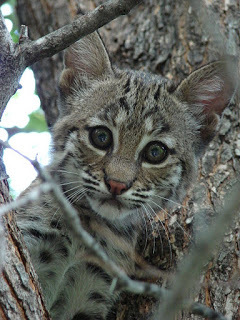 A bobcat kitten in Texas.Photo by Loadmaster (David R. Tribble).CC BY-SA 3.0, via Wikimedia Commons.
A bobcat kitten in Texas.Photo by Loadmaster (David R. Tribble).CC BY-SA 3.0, via Wikimedia Commons.Back in the early 1980s, archaeologists excavating a series of Native American burial mounds in western Illinois came across the skeleton of an animal that had been buried at the edge of one mound. It had been wearing a collar or necklace made of shells and bear teeth. The archaeologists thought it was a puppy. They were wrong.
It was actually a young bobcat, only four to seven months old, and it had been carefully buried by members of the Hopewell culture some two thousand years ago. The correct identification was only made in 2011, when another researcher took a fresh look at the bones and realized this was something special.
It was special, first, because the Hopewell people (hunter-gatherers who flourished in east-central North America from roughly 200 BC to AD 500) didn’t usually bury animals in those mounds. This is the only known example of an animal buried in this type of mound. Second, this is “the only decorated wild cat burial in the archaeological record.”
In all of archaeology, this little bobcat with its collar is the only wild cat known to have been given such a ceremonial burial.
Was the bobcat a pet—or something else?Now we have a question: Was this bobcat someone’s beloved pet?
It’s certainly possible. Perhaps a villager found the kitten orphaned or otherwise alone, helpless, and took it in to tame it. Just look at the picture at the top of this post and tell me, how could you not love a face like that?
Or perhaps the cat was something else. Perhaps it was revered as a symbolic, spiritual connection to nature.
Different researchers have their ideas, but the truth is, we may never know for sure. What we do know is that the bobcat was carefully buried and there were no signs of trauma on the skeleton. That means the kitten wasn’t sacrificed. Someone cared about it, and that’s good to know.
The study on the bobcat burial was recently published in the Midcontinental Journal of Archaeology .
Published on July 10, 2015 02:30
July 8, 2015
11th-Century Monkey Hugs Cat. Cat Hates It.
Wordless Wednesday
 Monkey and Cats
By Chinese artist Yi Yuanji.Ink on silk.
Monkey and Cats
By Chinese artist Yi Yuanji.Ink on silk.
11th century. Public domain, via Wikimedia Commons.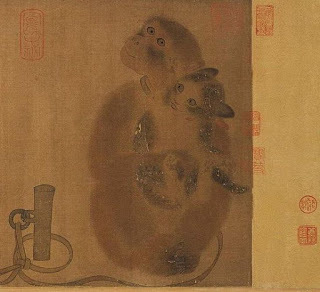 Monkey and Cats (detail)
By Chinese artist Yi Yuanji.The cat does not look happy.
Monkey and Cats (detail)
By Chinese artist Yi Yuanji.The cat does not look happy.
Ink on silk.
11th century. Public domain, via Wikimedia Commons.
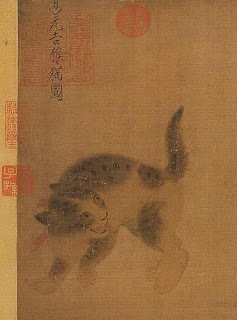 Monkey and Cats (detail)
By Chinese artist Yi Yuanji.Ink on silk.
Monkey and Cats (detail)
By Chinese artist Yi Yuanji.Ink on silk.
11th century. Public domain,
via Wikimedia Commons.
 Monkey and Cats
By Chinese artist Yi Yuanji.Ink on silk.
Monkey and Cats
By Chinese artist Yi Yuanji.Ink on silk.11th century. Public domain, via Wikimedia Commons.
 Monkey and Cats (detail)
By Chinese artist Yi Yuanji.The cat does not look happy.
Monkey and Cats (detail)
By Chinese artist Yi Yuanji.The cat does not look happy.Ink on silk.
11th century. Public domain, via Wikimedia Commons.
 Monkey and Cats (detail)
By Chinese artist Yi Yuanji.Ink on silk.
Monkey and Cats (detail)
By Chinese artist Yi Yuanji.Ink on silk.11th century. Public domain,
via Wikimedia Commons.
Published on July 08, 2015 02:30
Roby Sweet's Blog
- Roby Sweet's profile
- 7 followers
Roby Sweet isn't a Goodreads Author
(yet),
but they
do have a blog,
so here are some recent posts imported from
their feed.



